Instant Mobility System (IMS) Emergency Flat Tire Repair Kit
The IMS emergency flat tire repair kit included with your Mazda is for a temporary repair of a slightly damaged flat tire resulting from running over nails or similar sharp objects on the road surface.
NOTE:
Your vehicle is not equipped with a spare tire.
In the event of a flat tire, use the emergency flat tire repair kit to repair the tire temporarily.
When doing the repair, refer to the instructions included in the emergency flat tire repair kit.
After temporarily repairing a tire with the emergency flat tire repair kit, take your vehicle to an Authorized Mazda Dealer to have the tire replaced.
About the IMS Emergency Flat Tire Repair Kit
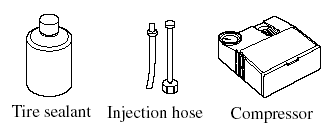
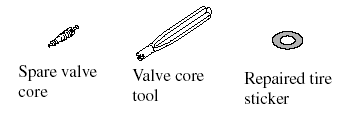

The IMS emergency flat tire repair kit includes the following items.
WARNING:
Do not allow children to touch the tire
sealant:
Ingestion of tire sealant is dangerous.
In the event tire sealant is accidentally swallowed, drink large amounts of water immediately and seek medical assistance.
Do not allow children to touch the tire
sealant:
Tire sealant that comes into contact
with the eyes and skin is dangerous.
If tire sealant enters the eyes or contacts the skin, flush immediately with large amounts of water and seek medical assistance.
NOTE:
- The tire sealant cannot be reused. Purchase
new tire sealant at an Authorized Mazda
Dealer.
- The emergency flat tire repair kit cannot be used in the following cases.
Consult an Authorized Mazda Dealer.
- The period of effective use for the tire sealant has expired. (The period of effectiveness is indicated on the bottle label.).
- The tear or puncture exceeds about 4 mm (0.16 in).
- The damage has occurred to an area of the tire other than the tread.
- The vehicle has been driven with nearly no air remaining in the tire.
- The tire has come off the wheel rim.
- Damage to the wheel rim has occurred.
- The tire has two or more punctures.
Using the IMS Emergency Flat Tire Repair Kit
1. Park on a level surface off the right-ofway and set the parking brake.
2. Put a vehicle with an automatic transmission in Park (P), a manual transmission in Reverse (R) or 1, and turn off the engine.
3. Turn on the hazard warning flasher.
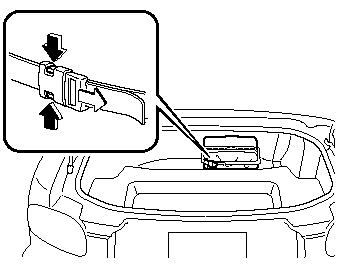
4. Unload passengers and luggage, and remove the emergency flat tire repair kit.
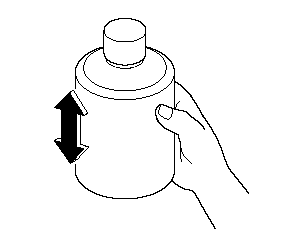
5. Shake the tire sealant well.
CAUTION:
If the bottle is shaken after the
injection hose is screwed on, tire
sealant could spray out from the
injection hose. Tire sealant
contacting clothing or other objects
may be impossible to remove. Shake
the bottle before screwing on the
injection hose.
NOTE:
The tire sealant can be used at outside
temperatures down to _30°C (_22°F).
In extremely cold temperatures (0°C (32°F) or below), the tire sealant hardens easily and injection of the sealant will be difficult. Warm the sealant inside the vehicle before doing the injection work.
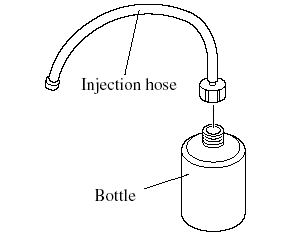
6. Remove the cap from the bottle. Screw on the injection hose with the bottle's inner cap left on to break the inner cap.
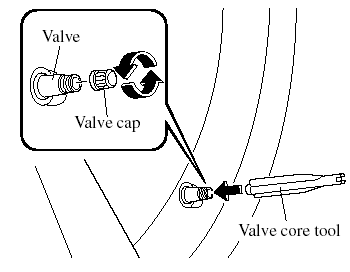
7. Remove the valve cap from the flat tire. Press the back of a valve core tool to the core of the tire valve and bleed all the remaining air.
CAUTION:
If there is air remaining in the tire
when the valve core is removed, the
valve core could fly out. Remove the
valve core carefully.
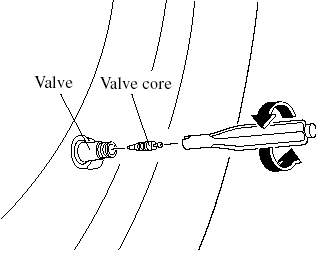
8. Turn the valve core counterclockwise with the valve core tool and remove the valve core.
NOTE:
Store the valve core in a place where it won't
get dirty.
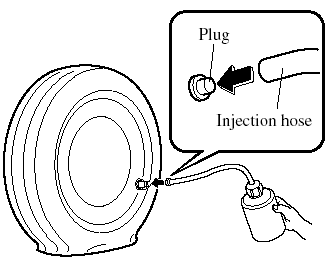
9. Remove the plug from the injection hose and insert the injection hose into the valve.
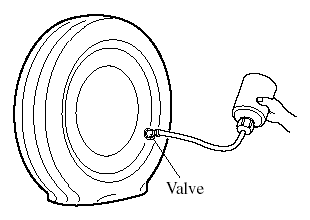
10. Hold the bottom of the bottle upright, squeeze the bottle with your hands, and inject the entire amount of tire sealant into the tire.
NOTE:
The tire sealant cannot be reused. Purchase a
new tire sealant kit at an Authorized Mazda
Dealer.
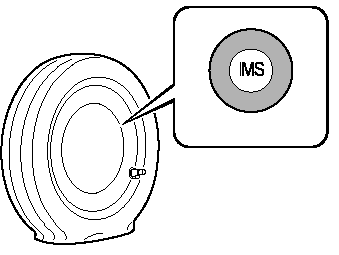
11. Pull out the injection hose from the valve. Reinsert the valve core into the valve and turn it clockwise to install it.
12. Attach the sticker that indicates completion of the tire repair on a flat outer surface of the repaired tire.
NOTE:
Do not throw away the empty tire sealant
bottle after use. Return the empty tire sealant
bottle to an Authorized Mazda Dealer when
replacing the tire. The empty tire sealant bottle
will need to be used to extract and dispose of
the used sealant from the tire.
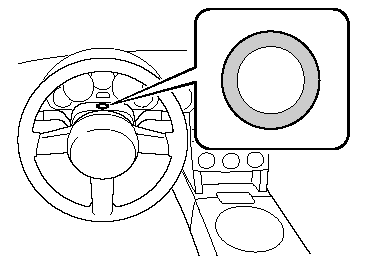
13. Attach the vehicle speed restriction sticker in a place where the driver can easily see it.
WARNING:
Do not attach the vehicle speed
restriction sticker to the instrument
panel, as it would obstruct vision of
areas such as warning light indicators
or the speedometer:
Attaching the vehicle speed
restriction sticker to the steering
wheel pad is dangerous. The sticker
could interfere with air bag inflation
and cause serious injury.
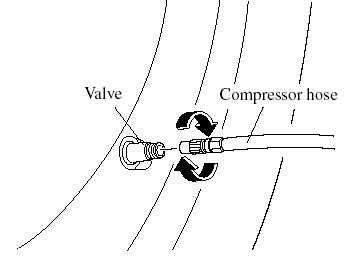
14. Install the compressor hose to the tire valve.
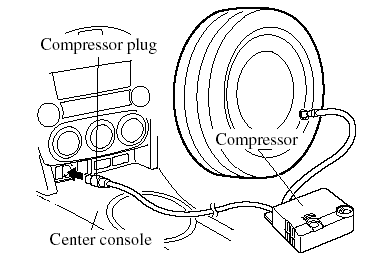
15. Insert the compressor plug into the interior accessory socket and turn the ignition switch to the ACC position.
CAUTION:
 Before pulling out the compressor
Before pulling out the compressor
plug from the electrical socket,
make sure the compressor power
switch is off.
 The compressor turns on and off
The compressor turns on and off
with the push-button switch.
16. Turn the compressor switch on and inflate the tire carefully to the correct inflation pressure.
WARNING:
Never operate the compressor above
300 kPa (3.1 kgf/cm2, 3 bar, 43.5 psi):
Operating the compressor above 300
kPa (3.1 kgf/cm2, 3 bar, 43.5 psi) is
dangerous. When the inflation
pressure rises above 300 kPa (3.1
kgf/cm2, 3 bar, 43.5 psi), heated air
will be exhausted from the back of
the compressor and you could be
burned.
CAUTION:
If the compressor operates slowly or
becomes hot, it indicates
overheating. Turn the compressor off
immediately and leave it turned off
for 30 minutes or longer.
NOTE
- Check the tire inflation pressure label (driver's door frame) for the correct tire inflation pressure.
- Do not use the compressor for longer than 10 minutes because using the compressor for long periods could damage it.
- If the tire does not inflate, repair of the tire may not be possible. If the tire does not reach the correct inflation pressure within a 10-minute period, it probably has received more extensive damage. When this happens, the emergency flat tire repair kit cannot be used to repair the tire. Contact an Authorized Mazda Dealer.
- If the tire has been over-inflated, loosen the screw cap on the compressor and bleed some of the air out.
17. When the tire has been inflated to the proper inflation pressure, turn the compressor switch off and remove the compressor hose from the tire valve.
18. Install the tire valve cap.
19. Put the emergency flat tire repair kit in the trunk and continue driving.
CAUTION:
 Drive carefully to an Authorized
Drive carefully to an Authorized
Mazda Dealer and keep the
vehicle speed below 80 km/h (50
mph).
 If the vehicle is driven 80 km/h (50
If the vehicle is driven 80 km/h (50
mph) or higher, the vehicle might
begin to vibrate.
20. After driving the vehicle for 10 minutes or 5 km (3 miles), check the tire pressure with the tire pressure gauge equipped with the compressor.
If the tire pressure has fallen below the correct tire pressure, inflate the tire to the correct pressure again following the steps from number 15.
CAUTION:
 If the tire inflation pressure falls
If the tire inflation pressure falls
below 130 kPa (1.3 kgf/cm2 or bar,
18.9 psi), repair cannot be done
with the repair kit. Park the
vehicle on a level surface off the
right-of-way and contact an
Authorized Mazda Dealer.
 If the tire inflation pressure
If the tire inflation pressure
continues to remain low after
repeating steps 14 to 21, park the
vehicle on a level surface off the
right-of-way and contact an
Authorized Mazda Dealer.
NOTE:
When checking the tire inflation pressure with
the tire pressure gauge on the compressor unit,
make sure the compressor switch is turned off.
21. If the tire inflation pressure remains stable, the tire repair is complete.
Drive the vehicle with care to an Authorized Mazda Dealer to have the tire replaced.
CAUTION:
 A tire that has been temporarily
A tire that has been temporarily
repaired with the tire sealant
cannot be reused. Mazda
recommends replacing the tire
with a new one.
 The wheel can be reused after any
The wheel can be reused after any
sealant adhering to it is wiped off
and carefully inspected. However,
replace the tire valve with a new
one.
Inspecting the IMS Emergency Flat Tire Repair Kit
Inspect the emergency tire repair kit at regular intervals.
- Check the tire sealant period of effective use.
- Check the operation of the tire compressor.
NOTE:
The tire sealant has a period of effective use.
Check the period of effective use indicated on the bottle label and do not use it if it has expired. Have the tire sealant replaced at an Authorized Mazda Dealer before the period of effective use has expired.
See also:
Moonroof
* Some models.
The moonroof can be opened or closed
electrically only when the ignition switch
is in the ON position.
WARNING:
Do not let passengers stand up or
extend part of their body throu ...
Interior Lights
qOverhead Light
Trunk Light ...
Mazda2 2009 review
The 2011 Mazda2 may very well be the cutest car I've driven to date. Despite
its more than adorable look, the Mazda2 and I took a few days to get to know
each other. Upon my first drive, I have to ...


